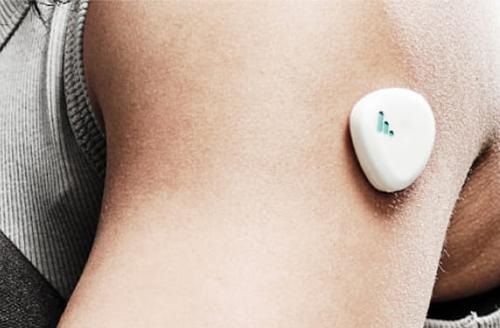Similar health monitoring devices have been popular with chronic disease patients and physicians who treat them; this technology may give clinical laboratories a new diagnostic tool
There is an ever-increasing number of companies working to develop lab testing technologies that would be used outside of the traditional clinical laboratory. One such example is Nutromics, an Australia-based medical technology company which recently announced it has raised US $14 million to fund its new lab-on-a-patch platform, according to a company press release.
Nutromics’ lab-on-a-patch device “uses DNA sensor technology to track multiple targets in the human body, including disease biomarkers and hard-to-dose drugs,” according to MobiHealthNews. Notably, Nutromics’ technology uses interstitial fluid as the sample source.
The funding, which is earmarked for clinical trials, research, and continued development of the technology, comes from health technology company Dexcom (through the Dexcom Ventures capital fund), VU Venture Partners, and global investment management firm Artesian Investments.
Nutromics raised $4 million last year to support a manufacturing facility and an initial human clinical trial of its “continuous molecular monitoring (CMM) platform technology that is able to track multiple targets in the human body via a single wearable sensor. The platform provides real-time, continuous molecular-level insights for remote patient monitoring and hospital-at-home systems,” MobiHealthNews reported.

“We are aiming to cause a paradigm shift in diagnostic healthcare by essentially developing a lab-on-a-patch. A lack of timely and continuous diagnostic insights can strongly impact outcomes when dealing with critical disease states. With this strategic industry and VC (venture capital) investment in us, we see more confidence in our technology and hope to accelerate our growth,” said entrepreneur and chemical engineer Peter Vranes (above), co-founder and CEO of Nutromics, in a press release. Clinical laboratory leaders have watched similar biometric monitoring devices come to fruition. (Photo copyright: Nutromics.)
.
How Nutromics’ Lab-on-a-Patch Works
“Our technology is, in fact, two technologies coming together—a marker and needle. What that does is give us access to fluid under your skin called interstitial fluid. If you’re going to measure something continuously, that’s a really good fluid [to measure],” Vranes told Outcomes Rocket.
Vranes calls the system’s aptamer-based sensor platform technology the “jewel in the crown.” An aptamer is a short sequence of artificial DNA or RNA that binds a specific target molecule. Nutromics’ aptamer sensor, Vranes said, enables targeting of analytes, unlike continuous glucose monitors (CGMs).
“[CGMs] are limited to metabolites—things that are already in the body like glucose and lactate. We’re not limited to those. We can do a whole range of different targets. And what that gives us is a ‘blue ocean’ opportunity to go in and solve problems in areas that other technologies just can’t solve,” Vranes said.
Nutromics plans to develop multiple aptamer-based sensors that measure a variety of analytes in interstitial fluid, Medtech Insight noted.

Nutromics’ wearable DNA sensor lab-on-a-patch technology (above) enables monitoring of multiple targets, including disease biomarkers and some medications, MobiHealthNews explained. The wearable patch contains microneedles that painlessly access interstitial fluid under the skin. Collected data is wirelessly transmitted to a software application and integrates with consumer health software and provider platforms, according to Nutromics. Medical laboratories could have a role in collecting this data and adding it other test results from patients using the wearable patch. (Photo copyright: Nutromics.)
Initial Launch Will Include Antibiotic Monitoring
Nutromics expects to initially launch therapeutic monitoring of vancomycin, a glycopeptide antibiotic medication used to treat various bacterial infections. The company says 60% of doses for this prescription antibiotic are not within therapeutic range.
The smart patch enables clinicians to give patients medicine “at the right dose and at the right time,” Sophie Stocker, PhD, a senior hospital scientist at St. Vincent’s Hospital Sydney and Senior Lecturer, University of Sydney School of Pharmacy in New South Wales, Australia, told MobiHealthNews.
Nutromics also envisions opportunity in acute kidney injury (AKI).
Other Research Using Microneedle Patch to Sample Interstitial Fluid
Nutromics is not alone in its use of a microneedle patch to access interstitial fluid (ISF) for diagnostics. In “Researchers at Washington University in St. Louis Use Microneedle Patch with Fluorescent Nanolabels to Detect Biomarkers in Skin’s Interstitial Fluid,” Dark Daily reported how engineers at the McKelvey School of Engineering at Washington University in St. Louis in Missouri have developed a disposable microneedle patch that one day could be a painless alternative to some blood draws for diagnostics tests and health monitoring.
Scientists at the Georgia Institute of Technology and Emory University in Atlanta have been studying interstitial fluid as a source of biomarkers, as compared to blood, for years.
“Interstitial fluid originates in the blood and then leaks out of capillaries to bring nutrients to cells in the body’s tissues. Because interstitial fluid is in direct communication with the cells, it should have information about the tissues themselves beyond what can be measured from testing the blood,” said Mark Prausnitz, PhD, Regents Professor and J. Erskine Love Jr. Chair, Georgia Tech School of Chemical and Biomolecular Engineering, in a 2020 news release announcing results of human trials of microneedle-based ISF sampling.
The scientists published their findings in the journal Science Translational Medicine titled, “Sampling Interstitial Fluid from Human Skin Using a Microneedle Patch.”
“We sampled interstitial fluid from 21 human participants and identified clinically relevant and sometimes distinct biomarkers in interstitial fluid when compared to companion plasma samples based on mass spectrometry analysis,” the scientists wrote.
Clinical laboratory leaders and pathologists will find it useful to monitor the development of diagnostics for use outside the lab. Nutromics is an example of a company developing wearable health technology that painlessly gathers data for lab tests to be conducted in point-of-care and near-patient settings.
—Donna Marie Pocius
Related Information:
Nutromics Raises US$14 Million For Its Ground-breaking Wearable Diagnostic Platform
Lab-on-a-Patch Maker Nutromics Scores $14M From Dexcom Ventures, Others
Nutromics Raises $14m as Dexcom Signals Move into Wider Sensing Capabilities
Extraction of Largely Unexplored Bodily Fluid Could be a New Source of Biomarkers
Sampling Interstitial Fluid from Human Skin Using a Microneedle Patch


